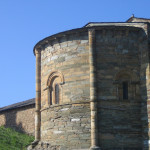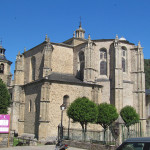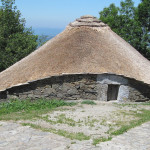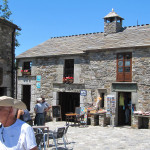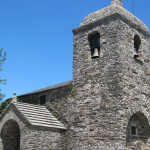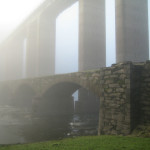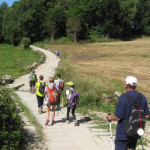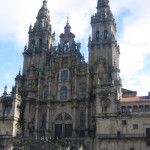The Camino Francés: Stretch 4 from Astorga to Santiago
1 pax min.
Stretch 4 from Astorga to Santiago de Compostela. We leave the Meseta Central to go into Galicia
Program
Day 1: Astorga
Transfer to Astorga with the opportunity to visit the city, above all the Cathedral and Gaudí’s Episcopal Palace
Day 2: From Astorga to Rabanal del Camino, 21 km approx.
Today we’ll enjoy the last stage in the plain Castilian Plateau before approaching Ponferrada and Galicia.
Across several typical Castilian villages we’ll reach Rabanal del Camino, where we can visit its parish church.
Day 3: From Rabanal del Camino to Molinaseca, sobre 26 km.
We leave definetly the Meseta and go uphill to the famous Cruz de Ferro, a huge iron cross where it’s traditional for pilgrims to carry small stones to lay on the mound.
Then the Camino drops down to the cute village of El Acevo which has a long narrow street full of attractive old houses with overhanging balconies. We continue going downhill through Riego de Ambrós until Molinaseca. We must be careful as the camino is full of stones on this track.
Before arriving in Molinaseca, we’ll cross the Roman bridge over the river Meruelo where pilgrims can take a refreshing bath in summer.
Day 4: From Molinaseca to Villafranca del Bierzo, 32 km approx.
We leave Molinaseca to approach Ponferrada where we can visit the Templar castle. We leave Ponferrada and come closer to the region of El Bierzo, well known by its wines and its particular climate due to its geographical borders with Galicia and Asturias.
We will pass through different villages along the camino, like Cacabelos where we can visit a Wine cellar. Today’s stage runs along vineyards as we get closer to Villafranca.
When entering Ponferrada we can visit the church of Santiago next to which there is a pilgrims’s cemetery.
* Upon request it`s possible to divide the stage, with an overnight stay in Ponferrada o Cacabelos, then we will add 1 day to the trip.
Day 5: De Villafranca del Bierzo a O Cebreiro, sobre 29 km.
We can notice from the accent of the people that we are about to enter Galicia Today’s stage is the toughest after the Pyrenees as we’ll go from 600m to 1200m.
Between Villafranca del Bierzo and Trabadelo (a village in half way of the stage) there are two variants.
One runs next to a main road and a river and the other, called Camino Duro, climbs a steep hill to drop later down to the river. The second one, as its name indicates, is quite tough but much more beautiful that the other one and 2 km longer. Only recommended if we are very fit as we have a long stage before us.
Today’s stage lead us through different towns before reaching our destination: the village of O Cebreiro. A former Celtic settlement where we’ll see the “Pallozas” reconstructed, typical round houses of Celtic origin. Before arriving we will see a sign indicating that we enter Galicia. It’s also Important to visit the parish church. In this town we will have the chance to try for the first time the Queimada, a typical Galician hot drink made of Galician liquor Orujo
* If you’d like to do the Camino Duro, but you don’t feel fit enough, there’s the possibility to divide the stage upon request with an overnight stay in Ambasmestas.
Day 6: From Cebreiro to Triacastela, 23 km approx.
Today we will have two mountain passes, the Alto de San Roque and the Alto de Poio, the last high point before Santiago,
at 1,337 meters. Then the camino goes gently downhill to Triacastela through small typical Galician villages like Viduedo.
Day 7: From Triacastela to Sarria, 20 km approx.
When leaving Triacastela there are two variants, one goes via Samos and the other runs along many villages and farms tracks.
The variant of Samos at the beginning runs next to a main road and it’s not very attractive but then we have the great opportunity to visit the monastery of Samos. It’s 4 km longer (24 km in total)
Both routes will go through typical Galician forests full of oaks and chestnut trees as well as many typical Galician villages and yards. On arriving in Sarria we can visit the old town located at the top of the city.
Day 8: From Sarria to Portomarín, 23 km approx.
We approach Santiago de Compostela as from Sarria there are about 115 km left. We will see how the number of pilgrims increases at this section considerably, since to receive the Compostela upon our arrival in Santiago we must have walked at least the last 100 km of one of the routes to Santiago
We leave Sarria through the old town, where we’ll see the parish church, a Romanesque church and the remains of a castle which was destroyed during the so-called “Revueltas Irmandiñas” which were peasant uprisings against the local nobility.
A few km away from Sarria, we will visit another Romanesque church in Barbadelos. Halfway along this stage we’ll pass by the milestone which indicates that we are 100 km to our destination. The stage climbs gently to the village of Ferreiros, where we’ll visit a Romanesque church. From there the camino drops towards Portomarín.
Before reaching Portomarín we cross the bridge over the River Miño, we are in the so called Belesar Reservoir. In Portomarín possibility to visit the Romanesque church of St. Nicholas.
Portomarín history is very interesting because the original village was submerged under water upon the construction of the reservoir and the Romanesque church was moved stone by stone to its current location.
Day 9: From Portomarín to Palas de Rei, 26 km approx.
First we descend to the reservoir and then we’ll start climbing the hill to the Monte San Antonio, from where we will reach the villages of Toxibó and Gonzar.
Then we will go through different villages and small towns like Hospital de la Cruz, Ventas de Naron and Eirexe until Palas de Rei.
Day 10: From Palas de Rei to Arzúa, 30 km approx.
When leaving Palas de Rei we’ll do a nice hike through forests to Coto.
About noon we’ll reach Melide, halfway point of the stage, where you can taste the octopus in one of its typical local cuisine restaurant called “pulpería”
Then across eucalyptus forests we will reach the village of Boente, from where we,ll walk to the village of Ribadiso before reaching Arzúa.
Day 11: From Arzúa to Lavacolla, 30 km approx.
This stage also goes through eucalyptus forests and brings us even closer to our destination. We’ll pass through different towns, among which you’ll find St. Irene and Amenal. In Lavacolla pilgrims were accustomed to have a bath in the river before entering the next day in Santiago.
Day 12: De Lavacolla a Santiago de Compostela, sobre 11 km.
Finally we get closer to our destination. We have ahead a short stage, perfect to reach the Cathedral of Santiago before 12 noon to attend to the Pilgrim’s Mass which is held every day at this time.
Before entering the city we will pass through the Monte del Gozo, whose name comes from the joy felt by the pilgrims when seeing the city for the first time.
Day 13: In Santiago de Compostela
Free day to visit this beautiful city, proclaimed a UNESCO World Heritage Site in 1985. We can visit the market town, Plaza de Abastos or one of its museums e.g. the Museum of Pilgrimages and the Cathedral Museum.
Transfer to the airport.
*There is the possibility to extend the stay in Santiago, if you are interested in it please don’t hesitate to contact Viajes Orbis. When extending your stay, apart from enjoying the city, we can arrange some excursions.
*It is also posible to combine various trips, e.g. follow the Way of Saint James until Finisterre.
- Villafranca del Bierzo
- Villafranca del Bierzo
- O Cebreiro
- O Cebreiro
- O Cebreiro
- Portomarín
Services we offer









